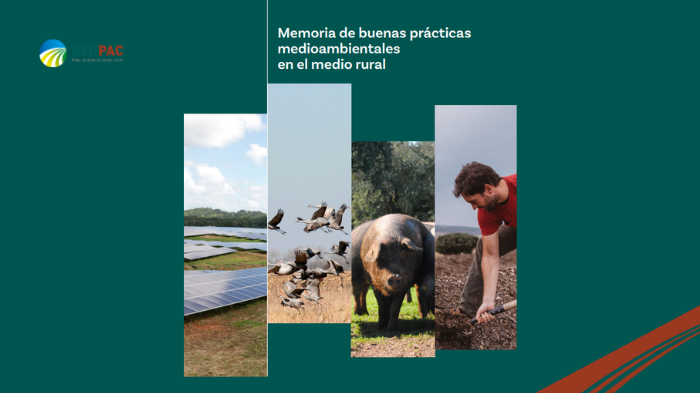
07 de March de 2025
Cambio climático y gestión de recursos naturales
Biodiversidad y paisaje
The PAC Network publishes the "Report on Good Environmental Practices in Rural Areas" with 22 successful projects developed in the 17 Spanish autonomous communities.
- The PAC Network publishes the "Report on Good Environmental Practices in Rural Areas" with 22 successful projects developed in the 17 Spanish autonomous communities.
- We call "good practices" those local entrepreneurship initiatives that solve problems or take advantage of opportunities in their territories, improving the lives of their inhabitants in the process.
- In the case of this report, the projects are funded through CAP support and European rural aid (EAFRD or EAGF funds).
Inspiring ideas put into practice by men and women who dedicate themselves to their communities. Local projects created and developed by and for the region in which they originate, supported mostly by Local Action Groups ( LAGs ). For the CAP Network , these are good practices , initiatives that —as defined by theEuropean CAP Network —are strategies, programs, projects, procedures, or management and implementation practices that meet the following characteristics:
- They have been tested and validated and have been implemented with positive results.
- They are successful and innovative.
- They can be developed and adapted to other contexts, that is, they are transferable.
- They contribute to improving their performance.
These are, above all, the facts and actions that improve the quality of life of the population, the sustainable management of resources, and the active participation of the stakeholders involved.
For this reason, the PAC Network gives them their well-deserved recognition through the publication of the "Report on good environmental practices in rural areas." with 22 successful projects developed in the 17 Spanish autonomous communities and financed with European agricultural and rural funds.
Project typologies
The 22 strategies compiled by the PAC Network present a wide variety of disciplines that address initiatives in their respective territories with a clear objective: to implement the coexistence of the agricultural environment and the environment so that nature allows them to improve the conditions and results of their work, always based on economic, social, and environmental sustainability. All of them, moreover, are characterized by being projects developed by a single person or a limited number of partners, rather than by large companies.
Thus, the projects exhibited are based on:
- Recovery of agroforestry biodiversity : these are the cases of New Worlds or Granja Zael , regenerative livestock businesses that are producing top-quality meat by restoring the health of the lands on which their animals graze. Or the Bioterreta farm complexes. and La Junquera , which rely on regenerative agriculture and the management of common lands to recover them, make them profitable or to repopulate an uninhabited village.
- Exploiting ecosystems: These include the Ibiza Beekeepers Association and the Olivos de Aragón project , which protect the genetic heritage of Ibizan bees and Aragonese olive varieties, respectively; the La Jarradilla cheese factory , which does the same with Pasiego cheeses; and the Revergeo project in Laguna de Gallocanta, which has converted an illegal landfill into a bird observatory.
- Affordable and sustainable energy: This report includes the examples of Ballesteros Genera , LICLE, Enfocc , and Calor Rural , which have developed community projects to better manage forest biomass in their areas and harness it for more efficient heat networks; Micorrizas , in La Rioja, which restores agricultural soils with symbiotic structures of fungi and roots; and La Palma Orgánica , which creates compost from organic household waste.
- Differentiated quality: some examples compiled in this document are Trasdeza Natur , which produces dehydrated apple snacks ; TerrAmor , with its mini kiwis; Vinyes Domènech and its wine production; the Extremadura-based Abona Global , with naturally formulated fertilizers; and the Valladolid-based Insectropía , which develops mealworm larvae that serve as food for farm livestock.
More examples can be found on the PAC Network website in the Good Practices Viewer , and initiatives deemed valid can be included upon request to the PAC Network.









